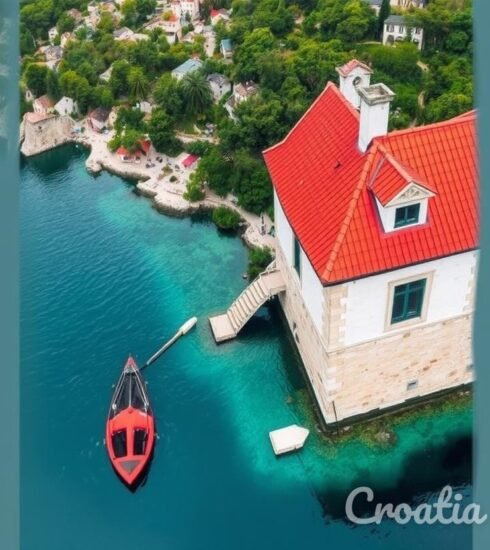Explore Hidden Croatia Heritage: Uncover Croatias Forgotten Passages
Journey Through Croatia’s Forgotten Passages: Chronicles of Lesser-Known Heritage Sites
Croatia, a beacon of historical rapture and cultural opulence, possesses an extraordinary tapestry of heritage sites that remain hushed in the shadow of the bustling Adriatic coastlines and iconic national parks. Today, we embark on an exhilarating exploration of these lesser-known passages, unlocking the chronicles of forgotten wonders that span across this enthralling nation.
1. The Enigmatic Castles and Fortresses
Deep within the verdant landscapes of Croatia lie ancient castles and fortresses that whisper tales of long-forgotten epochs. These structures, often overshadowed by the more popular sites, are testaments to the historical turbulence that the region has witnessed over the centuries.
- Trakošćan Castle: A romantic fortress nestled in the northwestern part of Croatia, Trakošćan boasts a history dating back to the 13th century. The castle is adorned with breathtaking Gothic and Renaissance elements.
- Veliki Tabor: Situated in the Hrvatsko Zagorje region, this stunning fortress offers a glimpse into the feudal life of the noble Ratkaj family during the 15th and 16th centuries.
Each of these castles not only showcases the architectural prowess of bygone eras but also serves as museums preserving cultural artifacts and offering tours that enrich visitors’ understanding of Croatia’s turbulent historical past.
2. Ancient Roman Vestiges
Croatia’s history is deeply intertwined with the Romans, leaving behind an opulent array of Roman vestiges that provide a glimpse into the ancient Roman Empire’s reach and influence. While many are familiar with the stunning Pula Arena, there are other Roman sites that remain unexplored by the masses.

- Salona: Once the capital of the Roman province of Dalmatia, the ruins of Salona near Split offer an expansive insight into Roman urban planning and lifestyle.
- Sissia: Located in the island of Hvar, this archaeological site unveils remnants of a significant Roman settlement.
These sites serve as an open history book, allowing travelers to walk the paths once trudged by Roman laureates and soldiers. The lesser-known monasteries are chronicled within an article available here, revealing hidden villages with deep roots in Roman culture.
3. Medieval Towns and Villages
Beyond the hype of Dubrovnik and Split, Croatia is home to a plethora of medieval towns and villages that capture the essence of tranquil, slower-pace life and illustrate the passage through medieval history.
- Motovun: Perched atop a hill in the Istrian peninsula, this tiny village is wrapped in stone walls that date back to the Middle Ages, offering panoramic views of the surrounding countryside.
- Hum: Known as the smallest town in the world, Hum preserves its medieval charm with cobblestone streets and rustic architecture.
Each of these villages radiates a unique blend of cultural richness and historical significance, meriting exploration for those seeking to uncover the less-trodden paths of Croatia.
Dive deeper into the intricate tales of such concealed villages by exploring explorative narratives here.
4. Sacred Sites and Age-Old Monasteries

Discovering Croatia’s sacred sites is a profound journey into the spiritual dimension of this historically rich nation. The country’s landscapes are dotted with majestic monasteries, some dating back to the early Middle Ages.
- Krka Monastery: Nestled in the Krka National Park, this Serbian Orthodox monastery is a serene sanctuary bearing historical and religious significance since its inception in the 15th century.
- Visovac Monastery: An enchanting Franciscan monastery perched on an island in the middle of Visovac Lake, offering a tranquil retreat surrounded by natural beauty.
These sites are imbued with a sense of sacredness and tranquility, often overlooked by mainstream tourism yet pivotal to understanding Croatia’s religious heritage.
5. Coastal Marvels Away From the Crowds
While Croatia’s coastal cities often draw in hordes of visitors, many equally spectacular maritime locations often remain beneath the radar. Venturing off the beaten path along the Adriatic Coast offers a voyage into untouched beauty and heritage.
- Lastovo Archipelago: Recognized for its pristine natural landscapes and lack of urban development, this group of islands is perfect for those yearning to explore nature in its purest form.
- Šibenik’s Fortresses: While many know Šibenik for its UNESCO-protected cathedral, its fortresses offer an adventure through the historical military might and strategic importance of the coastal city.
These locations not only cherish the pristine beauty of Croatia’s natural coastlines but are also enriched with history that narrates tales of maritime courage and resilience.
Unravel additional coastal gems that tuck away Croatian history by venturing into more explorations here.

6. The Intricacies of Local Traditions and Customs
Beyond tangible sites, Croatia’s intangible cultural heritage holds centuries-old customs and traditions still prevalent today. Participating in local festivals and markets presents an immersive experience into the traditional Croatian lifestyle.
- Sinjska Alka: A unique knights’ tournament dating back to the 18th century, celebrating the victory over the Ottomans.
- Pula’s Film Festival: Held in the iconic Pula Arena, this festival merges historical grandeur with contemporary cultural expressions.
Engaging in these cultural festivities offers an invaluable window into Croatia’s community life, preserving the essence of cultural convergence that has shaped its national identity.
7. Conclusion: A Timeless Journey Through Croatia
Croatia, with its wealth of hidden historical and cultural sites, offers a passage through time, unveiling stories and legends that have sculpted its present fabric. Each site we explored stands as a silent guardian, preserving the splendor, hardships, and empires that have traversed its landscapes.
Embarking on these lesser-trodden paths not only enriches one’s understanding of Croatia’s deep-rooted history but also fosters a profound appreciation for its continuous legacy. By venturing into the forgotten passages, one discovers a Croatia beyond tourist clichés—truly capturing the heart of this enchanting landscape.
As we conclude our journey, let us remember the unfettered joy of uncovering stories untold, and hidden gems tucked away from the world’s prying eyes. Every turn reveals a new chapter, a new era within the vast pages of Croatia’s book—a testament to its everlasting allure as a cradle of forgotten passages.






